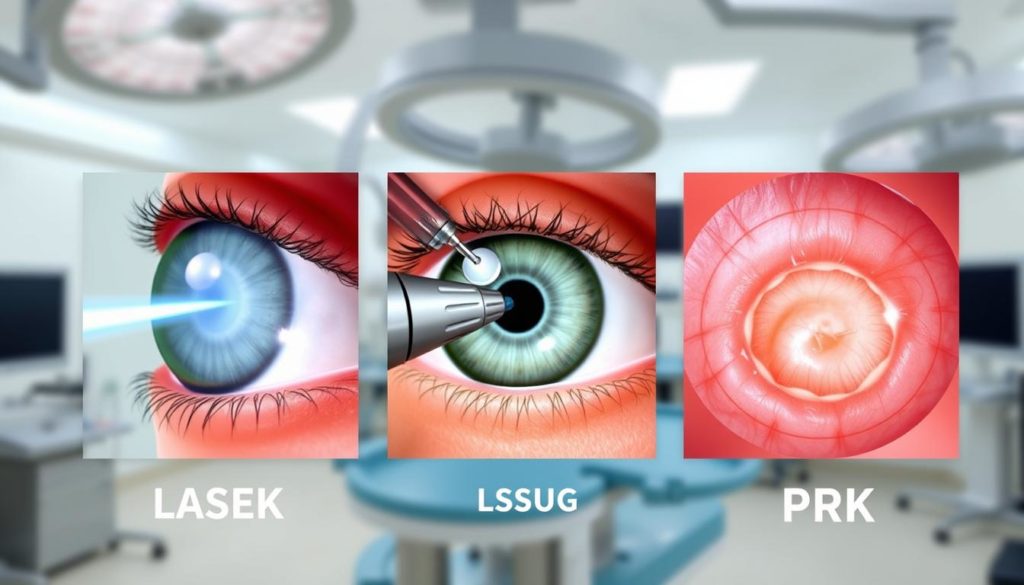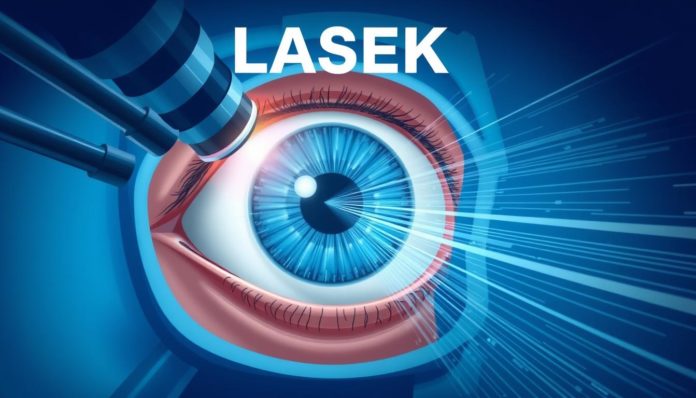Did you know over 700,000 laser eye surgeries happen in the U.S. each year? LASEK (Laser Assisted Sub-Epithelial Keratectomy) is becoming a popular choice. It’s an alternative to LASIK and PRK. This guide will explore LASEK, its process, and its benefits.
LASEK can fix nearsightedness, farsightedness, and astigmatism. It also makes recovery quick and painless. This guide will show why LASEK might be right for you.
Introduction to LASEK Eye Surgery
LASEK eye surgery, or Laser-Assisted Sub-Epithelial Keratectomy, is a big step in laser eye surgery. It’s a mix of PRK and LASIK, offering many benefits.

The history of LASEK surgery started in the early 1990s. Ophthalmologists wanted a way to avoid some LASIK problems. LASEK keeps the thin top layer of the cornea safe, making it better for people with thinner corneas.
The surgery softens the top layer with alcohol, moves it aside, and reshapes the cornea with an excimer laser. This careful method makes the benefits of LASEK clear. It leads to smoother healing and better surface regularity.
Many people can get LASEK, especially those who can’t have LASIK. Before surgery, doctors do a lot of checks to make sure it’s right for you.
LASEK stands out in the laser eye surgery comparison because of how it reshapes the cornea. It’s safer and works better, leading to fewer problems. Patients often feel less pain after surgery and see better faster than with PRK.
The benefits of LASEK are many, making it a great choice for those wanting better vision safely. As technology gets better, LASEK keeps improving, giving patients a safe and reliable option.
How LASEK Surgery Differs from LASIK and PRK
When you think about laser eye surgeries, it’s key to know the differences between LASEK, LASIK, and PRK. This knowledge helps you make a better choice.
Comparison with LASIK
LASEK vs LASIK is a common laser eye surgery comparison. The main difference is how the cornea is treated. LASIK creates a thin flap on the cornea with a special tool. This flap is then lifted to reshape the cornea with an excimer laser.
LASEK, on the other hand, doesn’t create a flap. It loosens the outer layer of the cornea with a diluted alcohol solution. Then, the corneal tissue is reshaped. This makes LASEK a good choice for those with thinner corneas.
Comparison with PRK
LASEK vs PRK shows another key difference. Both LASEK and PRK reshape the surface layer of the cornea without a flap. But PRK removes and discards the epithelium before reshaping. LASEK, however, keeps and repositions the epithelium after reshaping.
Because of this, LASEK usually heals faster and causes less discomfort than PRK.

LASEK Eye Surgery Overview
LASEK eye surgery reshapes the cornea with an excimer laser. It adjusts the cornea to improve vision. This surgery helps with many vision problems.
The LASEK eye surgery overview starts with detailed checks. These include measuring the cornea and testing vision. This ensures the surgery is tailored to each patient.
A key part of LASEK procedure steps is handling the epithelial layer. Unlike other surgeries, LASEK loosens this layer but keeps it safe. After reshaping, it’s put back in place. This helps the eye heal faster and reduces risks.
The excimer laser is crucial in LASEK surgery. It uses ultraviolet light to remove tiny parts of the cornea. This laser is very precise, which helps the eye heal quickly and improves vision.
LASEK surgery needs a skilled surgeon and precise equipment. Choosing a trusted clinic with experienced doctors is key for the best results.
Here’s a quick look at the LASEK procedure steps:
| Step | Description |
|---|---|
| Pre-operative Assessments | Comprehensive evaluations to determine candidacy for LASEK surgery. |
| Epithelial Layer Management | The epithelial layer is carefully loosened and preserved during surgery. |
| Corneal Reshaping | Excimer laser reshapes the cornea with high precision. |
| Repositioning Epithelial Layer | The epithelial layer is replaced to facilitate natural healing. |
| Post-Operative Care | Follow-up care to ensure proper healing and optimal vision improvement. |
Understanding the LASEK procedure steps helps patients see the value of this advanced eye surgery. It shows how carefully each step is done to improve vision.
Benefits of LASEK
In today’s fast world, vision correction surgery is a game-changer. LASEK, or Laser-Assisted Sub-Epithelial Keratectomy, stands out. It offers better vision, lower risks for some, and quicker healing.
Enhanced Vision Correction
LASEK is known for its top-notch vision correction. It shapes the cornea for clearer vision. Many see big improvements, needing glasses or contacts less.
The surgery’s precision means long-lasting, reliable results.
Reduced Risks for Certain Patients
LASEK is great for those with thin corneas or in risky jobs. It’s safer than LASIK, especially for athletes or workers in high-risk jobs. This is because it lowers the chance of flap problems.
Faster Recovery Times
LASEK’s quick recovery is a big plus. Patients can get back to normal fast, feeling little pain. It heals faster than other surgeries, making it a top choice for those wanting quick results.
Steps Involved in the LASEK Procedure
The LASEK procedure is carefully planned for safety and success. We’ll cover the main steps and talk about the recovery time.
Preparation Phase
Before surgery, a detailed eye check is done. This includes:
- Consultations to discuss medical history and expectations
- Comprehensive eye mapping for precise measurements
- Instructions regarding pre-surgery guidelines
On the day of the procedure, patients should avoid applying any eye makeup and adhere to fasting recommendations provided by their doctor.
Surgical Procedure
During the LASEK procedure, patients go through several steps:
- Application of numbing drops to ensure the eye is pain-free
- Gentle removal of the epithelial layer from the cornea
- Use of an excimer laser to reshape the cornea, improving focus
- Replacement of the epithelial layer and application of a special contact lens to aid healing
Post-Surgical Care
After surgery, following a strict care plan is key for a smooth recovery. Important parts of this phase include:
- Prescription eye drops to prevent infection and manage pain
- Wearing protective eyewear to shield the healing eye
- Follow-up appointments to monitor progress
By sticking to these guidelines, patients can speed up their recovery and get the best vision possible, reducing the LASEK recovery time.
LASEK Recovery Time: What to Expect
Knowing about LASEK recovery time is key for those thinking about this surgery. Healing times can differ, but most see their vision get better over weeks. Here’s what you might experience during recovery:
Right after surgery, you might feel some discomfort. This includes light sensitivity and a gritty eye feeling. These symptoms usually go away in a few days. Using eye drops as prescribed can help with pain and prevent infection.
In the first week, your vision might be blurry or change as your eyes heal. It’s best to avoid hard activities and follow your doctor’s advice for a smooth recovery. As your vision gets clearer, you’ll see the benefits of the surgery.
“Patience is key during the first few weeks of LASEK recovery. Gradual improvement is expected, but the results can be remarkable once the healing process is complete.”
Here are some tips for recovery at home:
- Rest your eyes as much as possible during the first few days
- Avoid rubbing your eyes to prevent irritation
- Wear sunglasses to protect your eyes from bright lights
- Use all prescribed medications as directed
- Keep follow-up appointments with your eye doctor
It’s important to watch your symptoms. If you have severe pain, vision loss, or unusual discharge, see your doctor right away. These could be signs of complications that need quick attention.
The expected LASEK recovery time is about one to two weeks for basic healing. Full vision recovery can take three to six months. The benefits of laser eye surgery are big, giving you clearer vision and less need for glasses.
Following the recovery process well and sticking to your doctor’s instructions will help you get the best results from your LASEK surgery.
Risks and Complications of LASEK
LASEK eye surgery can greatly improve your vision. But, it’s important to know the risks and complications. This knowledge helps you make a well-informed choice.
Common Risks
Common issues include dry eyes, vision problems, light sensitivity, and discomfort. These problems are usually short-term. But, they show why choosing safe laser eye surgery is key.
Knowing about these risks helps you prepare for recovery. It sets realistic expectations.
Serious Complications
Rare but serious problems can happen. These include scarring, infections, and long-lasting inflammation. These can affect your vision and healing time.
It’s vital to carefully consider the risks and benefits of LASEK. This helps you make a well-thought-out decision.
Minimizing Risks
To lower risks, choose a skilled surgeon and follow instructions carefully. Keeping in touch with your doctor is also important. These steps can make your laser eye surgery safer and reduce risks.
| Risk Type | Details |
|---|---|
| Dry Eyes | A common and typically temporary issue post-surgery. |
| Vision Disturbances | Includes halos, glare, and double vision. |
| Light Sensitivity | Increased sensitivity to light post-surgery. |
| Scarring | Rare but can impact vision quality long-term. |
| Infections | Serious but preventable with proper care and hygiene. |
Cost of LASEK Surgery in the United States
Thinking about LASEK eye surgery? It’s important to know the costs involved. This section will cover the average prices, insurance, and ways to pay for this vision correction surgery.
Average Costs
The cost of LASEK surgery varies a lot. It depends on where you are and the clinic. On average, it’s between $1,000 and $3,000 per eye. The price changes based on the surgeon’s skill, technology used, and location.
Cities and top clinics might cost more. But they offer better care and peace of mind.
Insurance Coverage
Most insurance plans don’t cover LASEK surgery costs. But, there are some exceptions. If LASEK is needed for medical reasons, you might get some help.
It’s key to check with your insurance to know what you’ll have to pay.
Financing Options
Worried about the cost of LASEK? There are ways to make it easier. Clinics offer payment plans to spread out the cost.
Medical credit lines like CareCredit also help. They let you pay back slowly. These options can make the cost more manageable.
FAQ
What is LASEK eye surgery?
LASEK (Laser-Assisted Sub-Epithelial Keratectomy) is a laser eye surgery. It corrects vision problems like nearsightedness and astigmatism. It reshapes the cornea to improve vision.
How does LASEK surgery differ from LASIK and PRK?
LASEK is different from LASIK and PRK. LASIK creates a flap in the cornea, and PRK removes the outer layer. LASEK loosens the cornea with alcohol and then reshapes it. This makes it better for people with thin corneas.
What are the benefits of LASEK surgery?
LASEK has many benefits. It corrects vision well, is good for thin corneas, and has a quicker recovery than other surgeries.
What steps are involved in the LASEK procedure?
The LASEK procedure has three steps. First, you get ready with consultations and eye mapping. Then, the surgery reshapes the cornea with a laser. Finally, you recover with follow-up visits and medication.
What is the recovery time for LASEK surgery?
Recovery from LASEK surgery takes a few days. You might feel uncomfortable and see things differently. But, you can usually go back to normal activities in a week. It can take months for your vision to fully recover.
What are the risks and complications of LASEK?
Risks of LASEK include dry eyes and vision problems. Serious issues like scarring and infection are rare. Choosing a good surgeon and following care instructions can help avoid these risks.
How much does LASEK surgery cost in the United States?
LASEK surgery costs vary. It can be between
FAQ
What is LASEK eye surgery?
LASEK (Laser-Assisted Sub-Epithelial Keratectomy) is a laser eye surgery. It corrects vision problems like nearsightedness and astigmatism. It reshapes the cornea to improve vision.
How does LASEK surgery differ from LASIK and PRK?
LASEK is different from LASIK and PRK. LASIK creates a flap in the cornea, and PRK removes the outer layer. LASEK loosens the cornea with alcohol and then reshapes it. This makes it better for people with thin corneas.
What are the benefits of LASEK surgery?
LASEK has many benefits. It corrects vision well, is good for thin corneas, and has a quicker recovery than other surgeries.
What steps are involved in the LASEK procedure?
The LASEK procedure has three steps. First, you get ready with consultations and eye mapping. Then, the surgery reshapes the cornea with a laser. Finally, you recover with follow-up visits and medication.
What is the recovery time for LASEK surgery?
Recovery from LASEK surgery takes a few days. You might feel uncomfortable and see things differently. But, you can usually go back to normal activities in a week. It can take months for your vision to fully recover.
What are the risks and complications of LASEK?
Risks of LASEK include dry eyes and vision problems. Serious issues like scarring and infection are rare. Choosing a good surgeon and following care instructions can help avoid these risks.
How much does LASEK surgery cost in the United States?
LASEK surgery costs vary. It can be between $1,000 and $3,000 per eye. Insurance might not cover it. But, there are financing options to help with the cost.
Is LASEK surgery covered by insurance?
Insurance usually doesn’t cover LASEK surgery. It’s seen as an elective procedure. But, some plans might offer partial coverage. It’s best to check with your insurance.
How can I minimize the risks associated with LASEK surgery?
To lower risks, pick a skilled surgeon and follow all instructions. Attend all follow-up appointments. These steps can help ensure a good outcome and reduce complications.
,000 and ,000 per eye. Insurance might not cover it. But, there are financing options to help with the cost.
Is LASEK surgery covered by insurance?
Insurance usually doesn’t cover LASEK surgery. It’s seen as an elective procedure. But, some plans might offer partial coverage. It’s best to check with your insurance.
How can I minimize the risks associated with LASEK surgery?
To lower risks, pick a skilled surgeon and follow all instructions. Attend all follow-up appointments. These steps can help ensure a good outcome and reduce complications.


